![]()
![]()
![]()
Use LEFT and RIGHT arrow keys to navigate between flashcards;
Use UP and DOWN arrow keys to flip the card;
H to show hint;
A reads text to speech;
44 Cards in this Set
- Front
- Back
- 3rd side (hint)
|
What are the different types of data? |
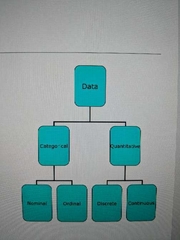
Nominal = without order (gender, colour) Ordinal = ordered (mild, mod, severe) Discrete = whole numbers (number of cases) Continuous = measurable value (height, weight) |
|
|
|
What is categorical data |
A type of qualitative data Grouped into categories (gender, what surgery, adverse event) Can have numerical component (ASA 1, 2, 3) |
|
|
|
What is ordinal data |
Type of categorical data which has a natural order (pain score out of 0 to 10, mild-moderate-severe, ASA score) |
|
|
|
What is numerical data |
Quantitative data - discrete: whole numbers (respiratory rate, number of MIs) - continuous: numbers can assume any value (weight: 33.55kg) |
|
|
|
Define mean, mode and median |
Mean is the average (sum of all values divided by total number of values)
Mode is the most common value
Median is the middle value in a set of values |
|
|
|
What is variance? |
How close each individual observation clusters about the mean |
|
|
|
What is the mathematical formula for standard deviation? |
√variance |
|
|
|
What is the standard error to the mean used for? |
Measuring precision |
|
|
|
What is the difference between accuracy and precision? |

|
|
|
|
Define incidence and prevalence |
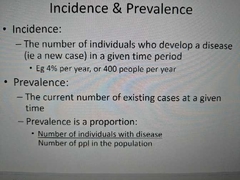
|
|
|
|
What is type 1 and type 2 error |
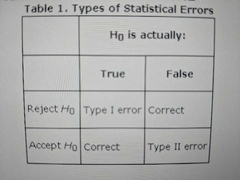
Type 1 error: incorrectly rejecting the true null hypothesis
Type 2 error: incorrectly accepting the false null hypothesis |
|
|
|
What does the students t test do |
Used to test the null hypothesis that there is no difference between the two means (can be used in sample sizes < 10) *** Compares the means between 2 groups only |
|
|
|
What does ANOVA do |
Tests for significance between the means of 2 or more groups in a normal distribution |
|
|
|
What is the use of Chi square |
Tests whether there will be a difference in frequency of categorical data between 2 or more groups |
|
|
|
What is the main feature of fishers exact test |
Another method to analyse categorical data - calculate CI for RR or OR |
|
|
|
What are the tests (in a decision tree) for comparing 2 or more independent groups? |
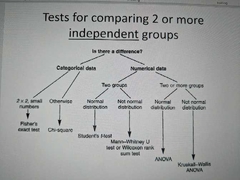
|
|
|
|
What are the tests (decision tree) for comparing 2 or more paired groups |
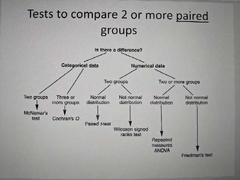
|
|
|
|
What test is best for categorical data with 2x2 small numbers (independent groups) |
Fishers exact test |
|
|
|
What test is used for categorical data with large numbers (independent groups) |
Chi squared |
|
|
|
What test is used for numerical data with 2 groups in a normal distribution (independent groups) |
Students t test |
|
|
|
What test is used for two groups of non parametric data |
Mann Whitney U test Or Wilcoxon rank sum test |
|
|
|
What test is used for numerical data of three or more groups with normal distribution |
ANOVA |
|
|
|
What test is used for numerical data of two or more groups with non normal distribution (independent groups) |
kruskall wallis (ANOVA) |
|
|
|
What test is used to compare paired categorical data for two groups |
Mcnemar test |
|
|
|
What test is used to compare paired categorical data for three or more groups |
Cochran's q |
|
|
|
What test is used to compare paired numerical data for two groups with normal distribution |
Paired t test |
|
|
|
What test is used to compare paired numerical data for two groups with non normal distribution |
Wilcoxon signed ranks test |
|
|
|
What test is used to compare paired numerical data for two or more groups with normal distribution |
ANOVA |
|
|
|
What test is used to compare paired numerical data for two or more groups with non normal distribution |
Friedman's test |
|
|
|
What is the formula for NNT |
1/ARR |
|
|
|
Formula for odds ratio |
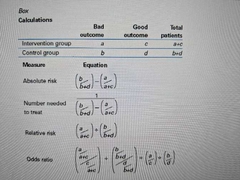
(odds of A) / (odds of b) (A/C) / (B/D) |
|
|
|
Define sensitivity and specificity |
Sensitivity: TP/(TP+FN)
Specificity: TN/(TN+FP) |
|
|
|
Define bias What are the different types of bias |

Recall bias: not recollecting events accurately
Observer bias: when not blinded
Recruitment bias: not randomising
Attrition bias: subjects being withdrawn
Publication bias: only publishing positive studies |
|
|
|
What is intention to treat analysis |
Including all participants assigned to an intervention group (even if it the intervention did not end up happening) |
|
|
|
What is the difference between systematic reviews and meta analysis |
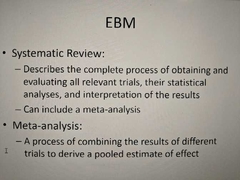
|
|
|
|
What is the difference between odds ratio and relative risk |
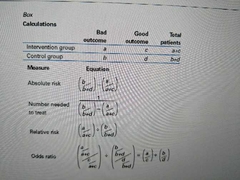
OR= (a/b) / (c/d) In other words odds of 'a' divided by odds of 'c'
RR = a/(a+b) / c/(c+d) Probability of 'a' divided by probability of 'c' |
|
|
|
What are the components of the CONSORT checklist for evaluating an RCT |
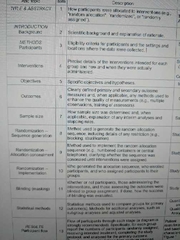
Check 'hint' for other parts |
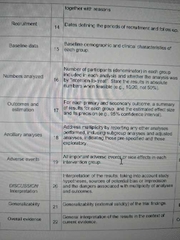
|
|
|
What is the central limit theorem? |
The sampling distribution of any statistic will be normal or nearly normal if the sample size is large enough (n > 50) |
|
|
|
What is the decision tree for using statistical tests for different types of data |
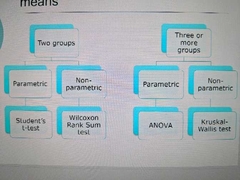
|
|
|
|
What is the difference between probability and odds |
Probability is the chance of an event occuring out of all possibilities. Odds is the chance of the event occuring divided by the chance of the event not occuring |
|
|
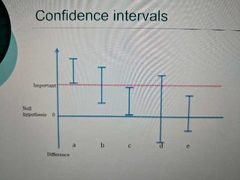
What is statistically / clinically significant |
A = statistically and clinically significant B = statistically significant but may not be clinically significant C = is only statistically significant D = is a poor study - can still potentially be statistically and clinically significant if CI can be reduced E = not clinically or statistically significant |
|
|
|
What are the EBM levels of evidence? |
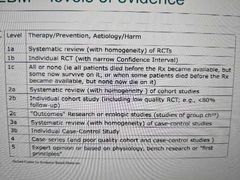
|
|
|
|
What are the 3 questions needed to be asked for critically appraising a study |

|
|
|
|
What is hazard ratio |
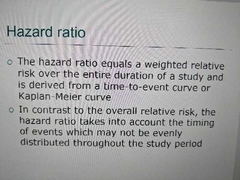
|
|

